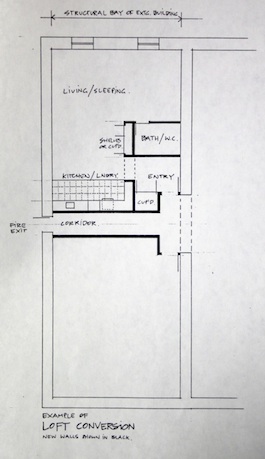Factory Records: FAC 101 (Tony Wilson's) Lofts
Notes: Disused warehouses in Manchester. TONY WILSON wanted to convert them into flats, but it never happened.
AHW: "We were visionary in that sense, that lofts would come one day. But we ran out of money - we were too busy with clubs and bars. We tried to explain lofts to people in Manchester and nobody understood it. We actually walked the Manchester Development corporation around a building in Sackville Street, which became lofts ten years later, and said 'These would make great lofts' and they went 'What are lofts?'"
A few notes for FAC 101:
The warehouse type building is firmly associated with the initial urban expansion of the English river port/city. However, the early brick warehouses of the industrial revolution are no longer commercially viable for storage and as a result most of these lie derelict. Given the warehouse was generated from an English prototype in the 18th and 19th centuries, some of the finest examples may be found in the 'industrial cities' particularly Manchester. Many of these warehouses occupy strategic positions close to the city centre and there is a great potential for conversion and re use. Demolition of the historic buildings would only serve to destroy the city's character and heritage.
There has developed a history of warehouse conversions in Europe and N.E. America over the last ten years which has largely been ignored in England. The conversion of warehouses into housing, often referred to as 'loft conversion', has steadily gained momentum, especially in New York City where the idea of the loft first achieved popularity.
The basic premise of the loft conversion is to adapt the structural shell of the warehouse into housing by the addition of services and dividing the often large spaces into appropriate room areas. The success of the conversion depends upon several factors - the condition of the building, the size of the structural bay, the location of the building and the possibility of introducing the necessary services.
The loft building caters for the housing needs of a large range of people who would like to remain close to the city centre. The loft is not meant to be a replacement of the traditional family home or an alternative form of flat accommodation but rather an additional housing type for people who would prefer different accommodation requirements that may readily adapt to changing city life styles.
The development of the loft conversion is obviously in its initial stages in this country and will require a good deal of commitment on the part of local government and developers if it is to become a reality."


Related content
- FAC 8 LINDER STERLING Factory Egg Timer[FCLUK, FIRST50, LINDER, CONCEPT]
- FAC 292 SHAUN RYDER Colours[FCLUK, SHAUN RYDER, SINGLE, UNDONE, HAPPY MONDAYS, ELECTRONIC, IDEA, CONCEPT]
- FAC 301 'First 50' [FCLUK, CONCEPT, UNDONE, TIM CHAMBERS]
- FACTUS 7 'Closer' Billboard[FACUS, ADVERTISEMENT, CONCEPT, JOY DIVISION]

